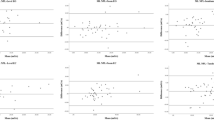Abstract
Aim: To assess the AccuSwayPLUS system, which aims to quantify deficiency in human balance, using the measurement of the effect of lorazepam on body sway in healthy volunteers.
Methods: A double-blind, randomised, placebo-controlled, two-way crossover study in 12 healthy male and female volunteers. Participants received a single oral dose of lorazepam 2mg and placebo, 1 week apart. Body sway was assessed using the AccuSwayPLUS system, by measuring the length of the path of the centre-of-pressure (COP), and the area of the 95% confidence ellipse enclosing the COP (A95). Body sway was assessed at baseline and at 2, 3, 4, 6, 12, 18 and 24 hours after administration, in two positions: with the participants’ eyes open and feet apart at hip’s width (EOFA), and with their eyes shut and feet together (ESFT).
Results: Statistically significant differences in body sway between lorazepam and placebo were detected for up to 18 hours after administration. The largest change in body sway was 2 hours post-dose, in the EOFA position; the mean (95% confidence interval) difference between lorazepam and placebo in fold change of A95 was 7.67 (3.88, 15.17), and in length of COP was 1.61 (1.23, 2.10).
Conclusion: The findings confirm that the AccuSwayPLUS system is a useful tool for detecting changes in body sway induced by centrally acting drugs.





Similar content being viewed by others
References
Fitzgerald JE, Murray A, Elliott C, et al. Comparison of balance assessment by sway magnetometry and force platforms. Arch Otolaryngol Head Neck Surg 1993; 119: 41–6
Dick RB, Bhattacharya A, Shukla R. Use of a computerised postural sway measurement system for neurobehavioral toxicology. Neurotoxicol Teratol 1990; 12: 1–6
Fitzgerald JE, Murray A, Elliott C, et al. Comparison of body sway analysis techniques. Acta Otolaryngol 1994; 114: 115–9
Rogind H, Simonsen H, Era P, et al. Comparison of Kistler 9861A force platform and Chattecx Balance System for measurement of postural sway: correlation and test-retest reliability. Scand J Med Sci Sports 2003; 13: 106–14
Lorazepam: datasheet compendium. London: Association of the British Pharmaceutial Industry, 1999
Patat A, Foulhoux P. Effect on postural sway of various benzodiazepine tranquillisers. Br J Clin Pharmacol 1985; 20: 9–16
Patat A, Perault MC, Vandel B, et al. Lack of interaction between a new antihistamine, mizolastine, and lorazepam on psychomotor performance and memory in healthy volunteers. Br J Clin Pharmacol 1995; 39: 31–8
Noachtar S, von Maydell B, Fuhry L, et al. Gabapentin and carbamazepine affect eye movements and posture control differently: a placebo-controlled investigation of acute CNS side effects in healthy volunteers. Epilepsy Res 1998; 31: 47–57
Wesnes KA, Garratt C, Wickens M, et al. Effect of sibutramine alone and with alcohol on cognitive function in healthy volunteers. Br J Clin Pharmacol 2000; 49: 110–7
Mattila MJ, Vanakoski J, Kalska H, et al. Effect of alcohol, zolpidem, and some other sedatives and hypnotics on performance and memory. Pharmacol Biochem Behav 1998; 59: 917–23
Letz R, Gerr F, Harris-Abbott D. Heterogeneity of effects of ethanol ingestion on postural stability as measured by two devices. Neurotoxicology 1994; 15: 603–7
Berlin I, Warot D, Hergueta T, et al. Comparison of the effects of zolpidem and triazolam on memory functions, psychomotor performances, and postural sway in healthy subjects. J Clin Pyschopharmacol 1993; 13: 100–6
Allain H, Bentue-Ferrer D, Tarral A, et al. Effects on postural oscillation and memory functions of a single dose of zolpidem 5mg, zopiclone 3.75mg and lormetazepam 1mg in elderly healthy subjects. Eur J Clin Pharmacol 2003; 59: 179–88
Tada K, Sato Y, Sakai T, et al. Effect of zopiclone, triazolam, and nitrazepam on standing steadiness. Neuropsychobiology 1994; 29: 17–22
Ledin T, Gupta A, Larsen LE, et al. Randomised perturbed posturography: methodology and effects of midazolam sedation. Acta Otolaryngol 1993; 113: 245–8
Mattila MJ, Mattila ME, Olkkola KT, et al. Effect of dexmedetomidine and midazolam on human performance and mood. Eur J Clin Pharmacol 1991; 41: 217–23
Van Steveninck AL, Gieschke R, Schoemaker RC, et al. Pharmacokinetic and pharmacodynamic interactions of bretazenil and diazepam with alcohol. Br J Clin Pharmacol 1996; 41: 565–73
Patat A, Klein MJ, Hucher M, et al. Acute effects of amitriptryline on human performance and interactions with diazepam. Eur J Clin Pharmacol 1988; 35: 585–92
McClelland G, Cooper S, Pilgrim A. A comparison of the central nervous system effects of haloperidol, chlorpromazine and sulpiride in normal volunteers. Br J Clin Pharmacol 1990; 30: 795–803
Liu YJ, Stagni G, Walden JG, et al. Thioridazine dose-related effects on biomechanical force platform measures of sway in young and old men. J Am Geriatr Soc 1998; 46: 431–7
Kollegger H, Wober C, Baumgartner C, et al. Stabilising and destabilizing effects of vision and foot position on body sway of healthy young subjects: a posturagraphic study. Eur Neurol 1989; 29: 241–5
Perneger T. What’s wrong with Bonferroni adjustments? BMJ 1998; 316: 1236–8
Rothman K. No adjustments are needed for multiple comparisons. Epidemiology 1990; 1: 43–6
Acknowledgements
Merck Sharp & Dohme Ltd supplied the lorazepam and placebo used in this study.
Dr Nicole Calder is a direct employee of Merck Sharp & Dohme Ltd in England. The authors have no conflicts of interest directly relevant to the content of this study.
Author information
Authors and Affiliations
Corresponding author
Rights and permissions
About this article
Cite this article
Norris, V., Baisley, K.J., Calder, N. et al. Assessment of the AccuSwayPLUS System in Measuring the Effect of Lorazepam on Body Sway in Healthy Volunteers. Int J Pharm Med 19, 233–238 (2005). https://doi.org/10.2165/00124363-200519040-00005
Published:
Issue Date:
DOI: https://doi.org/10.2165/00124363-200519040-00005




